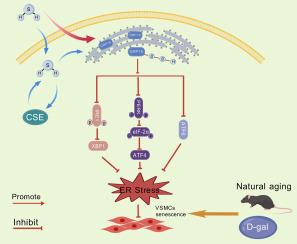硫化氢通过抑制内质网应激缓解血管平滑肌细胞衰老
IF 3.7
2区 生物学
Q2 CELL BIOLOGY
引用次数: 0
摘要
血管平滑肌细胞(VSMCs)的衰老导致血管结构和功能的退化,以及与年龄相关的心血管疾病。硫化氢(H2S)已被证实通过降低内质网(ER)应激来抑制各种心血管疾病的进展,但是否能通过抑制内质网应激来缓解VSMCs的衰老尚不清楚。在本研究中,细胞实验结果显示,10 g/L d -半乳糖(D-gal)增加了VSMCs的衰老、氧化应激、内质网应激相关蛋白(GRP78、CHOP)的表达,上调了IRE1-XBP1、PERK-eIF-2 α-ATF4和ATF6通路,降低了半胱甘氨酸γ -裂解酶(CSE)的表达和H2S的产生。补充H2S显著逆转了D-gal对上述指标的影响。同时,我们在自然衰老小鼠的血管组织中也观察到类似的结果。此外,自然衰老小鼠血管弹性纤维减少,胶原纤维积累,血管壁增厚,而补充H2S可以缓解这些现象。同时,我们还发现H2S可以恢复GRP78的s -巯基化水平。GRP78的敲低和Cys42突变完全取消了h2s介导的通过降低内质网应激对VSMCs衰老的抑制。我们的研究结果表明,H2S通过提高GRP78在Cys42位点的s -巯基化水平,通过下调IRE1-XBP1、PERK-eIF-2α-ATF4和ATF6通路,降低ER应激,从而延缓VSMCs的衰老。本文章由计算机程序翻译,如有差异,请以英文原文为准。

Hydrogen sulfide alleviates vascular smooth muscle cell senescence by inhibiting endoplasmic reticulum stress
The senescence of vascular smooth muscle cells (VSMCs) leads to the degeneration of vascular structure and function, as well as age-related cardiovascular diseases. Hydrogen sulfide (H2S) has been proven to suppress the progression of various cardiovascular diseases by decreasing endoplasmic reticulum (ER) stress, but it remains unclear whether it can inhibit ER stress to alleviate the senescence of VSMCs. In the present study, the results of cell experiments showed that 10 g/L D-galactose (D-gal) increased the VSMCs senescence, oxidative stress, the expression of ER stress related proteins (GRP78, CHOP) and up-regulated pathways of IRE1-XBP1, PERK-eIF-2 α-ATF4 and ATF6 as well as decreased the expression of the cystathionine gamma-lyase (CSE) and H2S production. H2S supplement significantly reversed the effect of D-gal on the above indicators. Meanwhile, we also observed similar results in vascular tissues of naturally aged mice. In addition, naturally aged mice exhibited reduction of vascular elastic fibers and accumulation of collagen fibers as well as thickening of the vascular wall, while supplementation with H2S was able to alleviate these phenomena. At the same time, we also found that H2S could restore the S-sulfhydration level of GRP78. The knockdown and the Cys42 mutation in GRP78 completely abrogated H2S-mediated suppression of VSMCs senescence by decreasing ER stress. Our results suggest that H2S can delay the senescence of VSMCs by decreasing ER stress by down-regulating IRE1-XBP1, PERK-eIF-2α-ATF4 and ATF6 pathways via increasing the S-sulfhydration level of GRP78 by the Cys42 site.
求助全文
通过发布文献求助,成功后即可免费获取论文全文。
去求助
来源期刊

Cellular signalling
生物-细胞生物学
CiteScore
8.40
自引率
0.00%
发文量
250
审稿时长
27 days
期刊介绍:
Cellular Signalling publishes original research describing fundamental and clinical findings on the mechanisms, actions and structural components of cellular signalling systems in vitro and in vivo.
Cellular Signalling aims at full length research papers defining signalling systems ranging from microorganisms to cells, tissues and higher organisms.
 求助内容:
求助内容: 应助结果提醒方式:
应助结果提醒方式:


